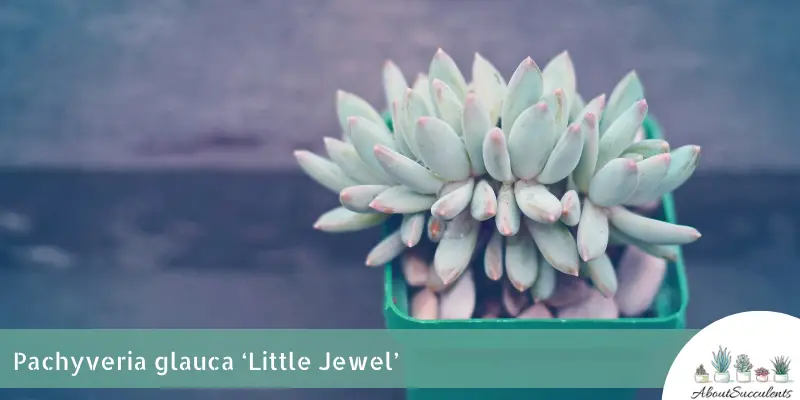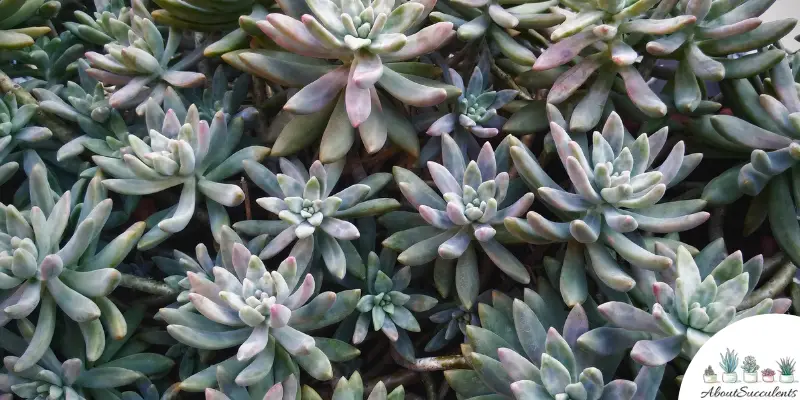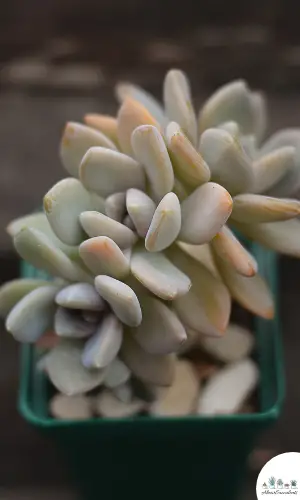
Pachyveria glauca, also known as ‘Little Jewel’ is a hybrid succulent plant that forms compact spiky rosettes of thick, tapered, cylindrical leaves.
The beautiful hues and shape of Pachyveria Glauca give it a striking resemblance to crystal clusters.
The leaves with red-violet tips can have a dusky green-gray or powdery blue-gray hue, depending on the season and light exposure. The leaves are coated with farina, a protective layer that prevents plant dehydration.
The ‘Little Jewel’ reaches a height of 10cm-15cm(4”-6”) and a width of 15cm (6”) upon maturity.
In winter, Pachyveria Glauca produces arched racemes of flowers with melon-colored interior and pink-tinted exterior.
Pachyveria Glauca is a hybrid of Pachyphytum and Echeveria. It is a part of the Pachyveria genus from the Crassulaceae family.
General Information:
Also known as: Little Jewel
Plant Family: Crassulaceae
Origin: Pachyveria Glauca is a hybrid of Pachyphytum and Echeveria which are both native to Mexico.
Height: 10cm – 15cm (4”- 6”)
Exposure: Full to Partial Sun
Water Needs: Drought-resistant; use the ‘Soak and Dry’ watering method
Soil Type: Cactus or Succulent potting mix with mineral grit such as thick sand and fine gravel in a 3:1:1 ratio
Soil pH: 5 to 7
How to Grow Pachyveria Glauca ‘Little Jewel’

Pachyveria Glauca is very easy to grow and care for. This adorable succulent will complement your dish gardens or rock gardens well.
This is not a cold-hardy plant and will die at temperatures below -6.7°C (20°F). Pachyveria Glauca can grow well indoors or outdoors at temperatures between 20°C -35°C (68°F-95°F).
Sunlight
Pachyveria Glauca loves to bask in natural light. If you will plant it in an outdoor garden, choose a location where it can get 5 to 6 hours of indirect morning and late afternoon sun.
Keep it away from direct mid-day sun to prevent sunburn. Indoors, place your container in a south-facing location where it will get plenty of natural light. A sunny window sill is also a perfect area for growing your ‘Little Jewel’.
If you do not have an area inside your house that gets plenty of natural light, get a grow light for your Pachyveria Glauca. Insufficient light will result in etiolation where the leaves stretch out to seek a light source.
Watering

Pachyveria Glauca does not need plenty of water. When it comes to succulents, the preferred watering method is the ‘soak and dry’.
When you water, give the soil a good soak. Allow it to dry out completely before your water again. Before watering, insert a stick into the soil and if it comes out dry you can proceed.
If you allow your Pachyveria Glauca to sit in waterlogged soil for too long, your adorable plant will get sick due to root rot. Make sure to water the soil only and avoid showering or spraying the leaves to prevent leaf rot.
Pachyveria Glauca actively grows during spring and fall so you need to water it every 5-6 days. The watering schedule will be less frequent during summer when it enters its dormant phase.
Pot and Soil
Use a terracotta or ceramic pot for your Pachyveria Glauca to ensure proper soil aeration and moisture evaporation. Get a pot with a drainage hole to prevent water retention.
Plant your ‘Little Jewel’ in a well-draining soil mix. Combine cactus or succulent potting soil with mineral grit such as thick sand and fine gravel in a 3:1:1 ratio.
The soil does not require fertilizer. However, you can feed your plant with a slow-release liquid fertilizer in winter, when it is actively growing.
How to Propagate Pachyveria Glauca ‘Little Jewel’
You can add more ‘Little Jewels’ to your succulents collection by using Leaf Cuttings and Stem Cuttings to propagate.
Method 1 – Leaf Cuttings
Step 1: Choose young and healthy leaves and cut them from the stem using a sterile sharp knife or pruning shears.
Step 2: Place the leaves in a warm area for a few days to allow the cut wounds to seal.
Step 3: When the wounds have been calloused, place the leaves on top of a slightly damp succulent mix.
Step 4: Mist your leaves every 2-3 days until little pups appear.
Step 5: Plant the little shoots in terracotta or ceramic pot filled with succulent or cactus mix combined with grit.
Method 2 – Stem Cuttings
Step 1: Use a sterile sharp knife or shears to cut healthy stems from the mother plant.
Step 2: Leave the stem cuttings in a warm area for a few days and wait for them to be calloused.
Step 3: Plant the calloused stem cuttings in terracotta or ceramic pots filled with cactus or succulent potting mix combined with plenty of gritty materials.
Step 4: Place the pots in a partially shaded area where they can get plenty of natural light. Mist the soil 4 to 5 times a day.
Frequently Asked Questions
Is Pachyveria Glauca ‘Little Jewel’ Toxic to Cats and Dogs?
Pachyveria Glauca is not included in the list of toxic plants on the website of the American Society for the Prevention of Cruelty to Animals (ASPCA).
Why is my Pachyveria Glauca Dying?
If your ‘Little Jewel’ is looking sick and distressed lately, it could be due to the following causes:
Overwatering
Overwatering is the most common mishap committed by succulent lovers. The good news is you can still save your over-soaked ‘Little Jewel’ specially if you detect the disease in its early stages.
Remove the plant from the pot. Gently brush soil off the roots and cut the damaged ones with a sterile sharp knife or garden shears.
Lay the plant in a dry container and place it somewhere bright but away from direct sunlight. Replant your ‘Little Jewel’ in terracotta or ceramic pot filled with cactus or succulent mix and mineral grit. Wait for a week before you water the plant.
Pest Infestation
Pachyveria Glauca is susceptible to mealybug infestation. These pesky pests drain the sap from succulents and if they are not removed early, your plant will die.
Use a paintbrush or cotton swab to dab the mealybugs with rubbing alcohol. 70% alcohol can kill these pests. You can also spray the plant with diluted neem oil to remove the mealybugs.
Pachyveria Glauca attracts slugs and snails too. Prevent them from feasting on your succulent gardens by scattering crushed eggshells, coffee grounds, or diatomaceous soil around the base of the plant or pot.
Does Pachyveria Glauca Produce Flowers?
Yes. During winter, Pachyveria Glauca ‘Little Jewel’ produces arched racemes of flowers with melon-colored interior and pink-tinted exterior.
Last Updated on June 9, 2022 by Sofia Lara